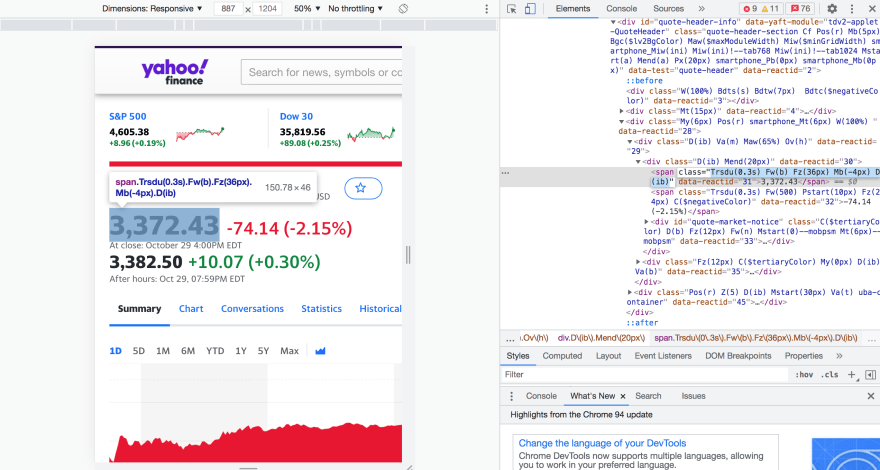23
Let's build a stock price CLI with Python
Are you someone who can't help checking the latest stock prices every 5 minutes? Thanks to Python, getting the latest stock prices can be as easy as running
python3 main.py AMZN in your terminal. In this tutorial, you will learn how to make a CLI with Python that:First things first, create a new python file. For this tutorial, I'll name mine
main.py
main.py. Once you have your new python file, import sys, BeautifulSoup and requests:main.py
import sys
import requests
from bs4 import BeautifulSoupOur CLI will need the user to input a ticker as a command-line argument after
main.py
python3 main.py. Using the sys library, we can check if the user has entered a ticker and make the CLI return an error if no ticker was provided or if too many tickers were provided. This CLI will then define the ticker variable as the second argument provided by the user:main.py
if len(sys.argv) > 2:
print('You have specified too many tickers')
sys.exit()
if len(sys.argv) < 2:
print('No ticker provided')
sys.exit()
ticker = sys.argv[1] # 0 = first argument and 1 = second argumentNow our CLI will need to scrape the provided ticker for it's latest price. We can do this using the
BeautifulSoup and requests libraries.The CLI will scrape the stock prices from yahoo finance. It will need to change the URL it scrapes based on the ticker entered by the user. Since the entered ticker gets stored inside the
main.py
ticker variable, following yahoo finance's url structure, the CLI can change the url variable based on the ticker like so:main.py
url = 'https://finance.yahoo.com/quote/' + ticker + '?p=' + ticker + '&.tsrc=fin-srch'
response = requests.get(url)Full code:
import os
import sys
import requests
from bs4 import BeautifulSoup
if len(sys.argv) > 2:
print('You have specified too many tickers')
sys.exit()
if len(sys.argv) < 2:
print('No ticker provided')
sys.exit()
ticker = sys.argv[1]
url = 'https://finance.yahoo.com/quote/' + ticker + '?p=' + ticker + '&.tsrc=fin-srch'
response = requests.get(url)For the actual scraping part, first go to a sample ticker's stock price webpage on yahoo finance. I'll choose AMZN for this tutorial. Locate the sample ticker's stock price element and right click on it. This will make a pop-up appear next to your cursor, click on the

inspect option:
Now that you have this element's
main.py
class property, to scrape this ticker's latest stock price, add the following code to main.py:main.py
soup = BeautifulSoup(response.text, 'html.parser')
price = soup.find('body').find(class_='Trsdu(0.3s) Fw(b) Fz(36px) Mb(-4px) D(ib)')
print('Latest stock price: ' + price.text.strip())This code will find the stock price element through it's class property and display it's text contents using
price.text.strip().Full code:
import os
import sys
import requests
from bs4 import BeautifulSoup
if len(sys.argv) > 2:
print('You have specified too many tickers')
sys.exit()
if len(sys.argv) < 2:
print('No ticker provided')
sys.exit()
ticker = sys.argv[1]
url = 'https://finance.yahoo.com/quote/' + ticker + '?p=' + ticker + '&.tsrc=fin-srch'
response = requests.get(url)
soup = BeautifulSoup(response.text, 'html.parser')
price = soup.find('body').find(class_='Trsdu(0.3s) Fw(b) Fz(36px) Mb(-4px) D(ib)')
print('Latest stock price: ' + price.text.strip())One last thing!
Put the last piece of code into a
Put the last piece of code into a
try: statement and return an error if the user entered an invalid ticker:import os
import sys
import requests
from bs4 import BeautifulSoup
if len(sys.argv) > 2:
print('You have specified too many tickers')
sys.exit()
if len(sys.argv) < 2:
print('No ticker provided')
sys.exit()
ticker = sys.argv[1]
url = 'https://finance.yahoo.com/quote/' + ticker + '?p=' + ticker + '&.tsrc=fin-srch'
response = requests.get(url)
try:
soup = BeautifulSoup(response.text, 'html.parser')
price = soup.find('body').find(class_='Trsdu(0.3s) Fw(b) Fz(36px) Mb(-4px) D(ib)')
print('Latest stock price: ' + price.text.strip())
except:
print('Invalid ticker')I hope this article helped you learn about CLI development in Python, as well as gave you a fun and useful Python project idea.
23





